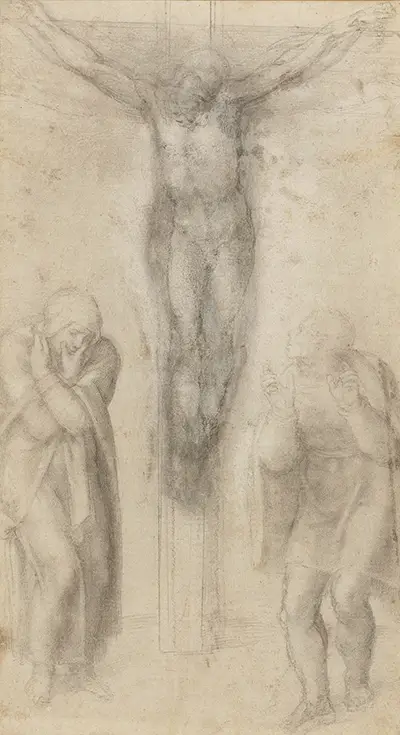This Renaissance master may have been gifted with some extraordinary natural talent, but he also worked tirelessly in order to perfect his craft. You will find countless study drawings from his career which detail individual components that he would focus on individually before then producing more compex arrangements, fusing many of these components together. As his career and experience developed he would feel more confident in being able to work a little more quickly, because of the muscle memory that he had built up through this endless practice. That said, he continued to sketch throughout his lifetime and never took his ability for granted, even though many considered him to be an arrogant and sometimes prickly figure to deal with personally. Incidentally, there is a near identical drawing to this one, titled Christ on the Cross with the Virgin and St John.
The drawing found here features a fairly simple composition, with Christ placed centrally on the cross, with the Virgin to the left and St John to the right. The two standing figures look distraught at was has happened. The detail concentrates on the three figures, with little concern for the background. Even the foreground is just a few strokes of charcoal to indicate the ground on which they are standing. Even the cross itself is minimal in detail, with Michelangelo concentrating on the three figures, their clothing, their facial expressions, and also the shadows around their physical features. Despite its age, the drawing is clearly still in fairly good condition and will now receive exceptional care due to its significance and also the fragile nature of paper from that period. These artworks will not be placed on display as much as Michelangelo's paintings and sculptures because of their sensitivity to sunlight and general wear and tear.
The most famous depiction of this scene would be Michelangelo's Crucifix which was mainly made out of wood. The drawing found here was produced using black chalk and white heightening, which was very common for artists during this period of the Renaissance. The white touches would generally be added at the end, in order to increase a feeling of depth and lighting to the piece, as well as help to lead the eye to the important parts of the artwork. The simplicity of these tools also meant that there were no overheads to drawing, so Michelangelo could put together his work whilst travelling around the country, without the need to carry huge amounts of tools with him as he went. Michelangelo himself followed on in the footsteps of a number of highly skilled Italian draughtsman who had come about in previous centuries and helped to push ideas and techniques onwards from the earlier methods of the Middle Ages. He himself would have been particularly interested in the work of Masaccio and Giotto who were integral to the early stages of the Renaissance.


